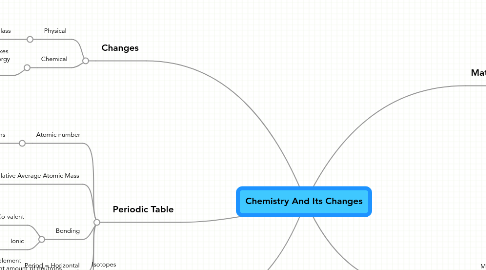
1. Changes
1.1. Physical
1.1.1. Example: Breaking glass
1.2. Chemical
1.2.1. reaction occurs, makes something new, energy change
2. Elements
2.1. Isotopes
2.1.1. - Still same element - But different amount of neutrons
2.2. Diatomic
2.2.1. Grouped in pairs
2.2.2. 7 and 1 - Have No Fear Of Ice Cold Beverages - Hydrogen, Nitrogen, Fluorine, Oxygen, Iodine, Chlorine, and Bromine
3. Periodic Table
3.1. Atomic number
3.1.1. # of protons
3.2. Relative Average Atomic Mass
3.2.1. # of neutrons and protons
3.2.2. Relative to Carbon 12
3.2.3. Average of isotops
3.3. Bonding
3.3.1. Co-valent
3.3.1.1. 2 non-metals sharing electrons
3.3.2. Ionic
3.3.2.1. -1 metal and 1 non-metal gaining/losing electrons to become stable - metal gives/loses, non metal gains
3.4. Period = Horizontal
3.5. Group/Family = Vertical
4. Matter
4.1. Mass
4.1.1. All matter has mass, measurement of inertia
4.2. Volume
4.3. 3 states
4.3.1. Solid
4.3.1.1. -melts to a liquid, sublimates to a gas - definite shape and volume - vibration
4.3.2. Liquid
4.3.2.1. -fuses to a solid, and vaporization - indefinite shape, and definite volume - rotation and vibration
4.3.3. Gas
4.3.3.1. - condenses to a liquid, sublimates to a solid - undefinite shape, and undefinite volume - translation, rotation, and vibration
